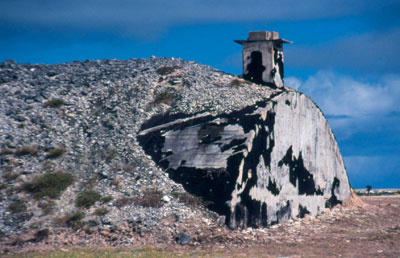Rare tour to Wake Island
For those not in the US military, it has been virtually impossible to visit Wake Island, “the Alamo of the Pacific.” After several failed attempts, I had almost given up.
Finally, permission was granted to Valor Tours along with Military Historical Tours to take a group of 141 to that most difficult destination. The “Return to Wake” tour, Dec. 8-12, 2009, cost $3,500, including round-trip airfare from Honolulu, Hawaii, to Wake.
Our tour group represented over a dozen nations and included some survivors of the 1941 invasion of the island.
Located between Hawaii and the Northern Mariana Islands in the North Pacific, Wake Island comprises three atolls totaling about six square miles in area. Its highest point is 21 feet above sea level.
During the 1930s, Pan American Clipper seaplanes used it as a refueling stop. The US Navy realized its strategic importance and began to use it as a base.
After Pearl Harbor, Japanese air raids destroyed much of Wake’s airfield and supply depots. On Dec. 11, 1941, there was an attempted Japanese landing that was repulsed by US forces, but on Dec. 21, facing the reality of the situation, the last US military floatplanes (PBYs) departed from the island, and two days later the remaining military personnel and civilian contractors on Wake surrendered to invading Japanese soldiers and remained under Japanese control until the end of the war.
Today, Wake is used by the US Strategic Air Command as a base for tracking launched missiles. It is home to about 300 support personnel.
Our tour began in Hawaii, from which we flew Continental’s Air Micronesia (Air Mic) to Guam. Ironically, we flew over Wake on this flight. A day later, on Dec. 5, we took off in our Air Mic charter plane at 5 a.m. There were no accommodations for our group on Wake, so we would arrive at sunrise and leave at sunset. The airline supplied box lunches.
Before landing, the plane circled the atoll several times, providing views of the missile defense station. Inside the Wake Air Station was an airport lounge with a small museum, a souvenir/duty-free shop and a post office. Our passports were rewarded with a large Wake Island stamp.
Our group was divided onto two buses, each traveling in opposite directions and eventually covering all the sights. We passed stores, housing and a church and stopped to visit Prisoners’ Rock, where a plaque marks the location of MacArthur’s 1950 meeting with Truman, and the Drifter’s Reef Bar & Grill, where premium beers cost only $2.
We also saw the remains of the Pan American Hotel and a ramp into the ocean for seaplanes. Large jet-fuel storage tanks were scattered about the island.
After our bus tour we had free time, and some of our group swam in the lagoon. Wake currently boasts excellent fishing and scuba diving and a nine-hole golf course. As we were exploring, Wake Islanders frequently stopped to offer us a ride. Most of the civilian workers are from Thailand. (Most signs are written in both English and Thai.)
In a ceremony toward the end of the day, a 90-year-old survivor of Wake laid a wreath at the Marine Memorial.
Was the trip worth around $1,000 a day? You betcha! Although from start to finish it lasted less than a week, it was the best short trip I can imagine and very special for all involved.
I am grateful for the perseverance of Valor Tours, Ltd. (Sausalito, CA; 800/842-4504, www.valortours.com ), and Military Historical Tours (Woodbridge, VA; 800/722-9501, www.miltours.com) in arranging this trip. This tour may be repeated in 2010.
BILL ALTAFFER
San Diego

